Wednesday, October 28th 2020

AMD Announces the Radeon RX 6000 Series: Performance that Restores Competitiveness
AMD (NASDAQ: AMD) today unveiled the AMD Radeon RX 6000 Series graphics cards, delivering powerhouse performance, incredibly life-like visuals, and must-have features that set a new standard for enthusiast-class PC gaming experiences. Representing the forefront of extreme engineering and design, the highly anticipated AMD Radeon RX 6000 Series includes the AMD Radeon RX 6800 and Radeon RX 6800 XT graphics cards, as well as the new flagship Radeon RX 6900 XT - the fastest AMD gaming graphics card ever developed.
AMD Radeon RX 6000 Series graphics cards are built upon groundbreaking AMD RDNA 2 gaming architecture, a new foundation for next-generation consoles, PCs, laptops and mobile devices, designed to deliver the optimal combination of performance and power efficiency. AMD RDNA 2 gaming architecture provides up to 2X higher performance in select titles with the AMD Radeon RX 6900 XT graphics card compared to the AMD Radeon RX 5700 XT graphics card built on AMD RDNA architecture, and up to 54 percent more performance-per-watt when comparing the AMD Radeon RX 6800 XT graphics card to the AMD Radeon RX 5700 XT graphics card using the same 7 nm process technology.AMD RDNA 2 offers a number of innovations, including applying advanced power saving techniques to high-performance compute units to improve energy efficiency by up to 30 percent per cycle per compute unit, and leveraging high-speed design methodologies to provide up to a 30 percent frequency boost at the same power level. It also includes new AMD Infinity Cache technology that offers up to 2.4X greater bandwidth-per-watt compared to GDDR6-only AMD RDNA -based architectural designs.
"Today's announcement is the culmination of years of R&D focused on bringing the best of AMD Radeon graphics to the enthusiast and ultra-enthusiast gaming markets, and represents a major evolution in PC gaming," said Scott Herkelman, corporate vice president and general manager, Graphics Business Unit at AMD. "The new AMD Radeon RX 6800, RX 6800 XT and RX 6900 XT graphics cards deliver world class 4K and 1440p performance in major AAA titles, new levels of immersion with breathtaking life-like visuals, and must-have features that provide the ultimate gaming experiences. I can't wait for gamers to get these incredible new graphics cards in their hands."
Powerhouse Performance, Vivid Visuals & Incredible Gaming Experiences
AMD Radeon RX 6000 Series graphics cards support high-bandwidth PCIe 4.0 technology and feature 16 GB of GDDR6 memory to power the most demanding 4K workloads today and in the future. Key features and capabilities include:
Powerhouse Performance
In the coming weeks, AMD will release a series of videos from its ISV partners showcasing the incredible gaming experiences enabled by AMD Radeon RX 6000 Series graphics cards in some of this year's most anticipated games. These videos can be viewed on the AMD website.
AMD Radeon RX 6000 Series graphics cards are built upon groundbreaking AMD RDNA 2 gaming architecture, a new foundation for next-generation consoles, PCs, laptops and mobile devices, designed to deliver the optimal combination of performance and power efficiency. AMD RDNA 2 gaming architecture provides up to 2X higher performance in select titles with the AMD Radeon RX 6900 XT graphics card compared to the AMD Radeon RX 5700 XT graphics card built on AMD RDNA architecture, and up to 54 percent more performance-per-watt when comparing the AMD Radeon RX 6800 XT graphics card to the AMD Radeon RX 5700 XT graphics card using the same 7 nm process technology.AMD RDNA 2 offers a number of innovations, including applying advanced power saving techniques to high-performance compute units to improve energy efficiency by up to 30 percent per cycle per compute unit, and leveraging high-speed design methodologies to provide up to a 30 percent frequency boost at the same power level. It also includes new AMD Infinity Cache technology that offers up to 2.4X greater bandwidth-per-watt compared to GDDR6-only AMD RDNA -based architectural designs.
"Today's announcement is the culmination of years of R&D focused on bringing the best of AMD Radeon graphics to the enthusiast and ultra-enthusiast gaming markets, and represents a major evolution in PC gaming," said Scott Herkelman, corporate vice president and general manager, Graphics Business Unit at AMD. "The new AMD Radeon RX 6800, RX 6800 XT and RX 6900 XT graphics cards deliver world class 4K and 1440p performance in major AAA titles, new levels of immersion with breathtaking life-like visuals, and must-have features that provide the ultimate gaming experiences. I can't wait for gamers to get these incredible new graphics cards in their hands."
Powerhouse Performance, Vivid Visuals & Incredible Gaming Experiences
AMD Radeon RX 6000 Series graphics cards support high-bandwidth PCIe 4.0 technology and feature 16 GB of GDDR6 memory to power the most demanding 4K workloads today and in the future. Key features and capabilities include:
Powerhouse Performance
- AMD Infinity Cache - A high-performance, last-level data cache suitable for 4K and 1440p gaming with the highest level of detail enabled. 128 MB of on-die cache dramatically reduces latency and power consumption, delivering higher overall gaming performance than traditional architectural designs.
- AMD Smart Access Memory - An exclusive feature of systems with AMD Ryzen 5000 Series processors, AMD B550 and X570 motherboards and Radeon RX 6000 Series graphics cards. It gives AMD Ryzen processors greater access to the high-speed GDDR6 graphics memory, accelerating CPU processing and providing up to a 13-percent performance increase on a AMD Radeon RX 6800 XT graphics card in Forza Horizon 4 at 4K when combined with the new Rage Mode one-click overclocking setting.9,10
- Built for Standard Chassis - With a length of 267 mm and 2x8 standard 8-pin power connectors, and designed to operate with existing enthusiast-class 650 W-750 W power supplies, gamers can easily upgrade their existing large to small form factor PCs without additional cost.
- DirectX 12 Ultimate Support - Provides a powerful blend of raytracing, compute, and rasterized effects, such as DirectX Raytracing (DXR) and Variable Rate Shading, to elevate games to a new level of realism.
- DirectX Raytracing (DXR) - Adding a high performance, fixed-function Ray Accelerator engine to each compute unit, AMD RDNA 2-based graphics cards are optimized to deliver real-time lighting, shadow and reflection realism with DXR. When paired with AMD FidelityFX, which enables hybrid rendering, developers can combine rasterized and ray-traced effects to ensure an optimal combination of image quality and performance.
- AMD FidelityFX - An open-source toolkit for game developers available on AMD GPUOpen. It features a collection of lighting, shadow and reflection effects that make it easier for developers to add high-quality post-process effects that make games look beautiful while offering the optimal balance of visual fidelity and performance.
- Variable Rate Shading (VRS) - Dynamically reduces the shading rate for different areas of a frame that do not require a high level of visual detail, delivering higher levels of overall performance with little to no perceptible change in image quality.
- Microsoft DirectStorage Support - Future support for the DirectStorage API enables lightning-fast load times and high-quality textures by eliminating storage API-related bottlenecks and limiting CPU involvement.
- Radeon Software Performance Tuning Presets - Simple one-click presets in Radeon Software help gamers easily extract the most from their graphics card. The presets include the new Rage Mode stable over clocking setting that takes advantage of extra available headroom to deliver higher gaming performance.
- Radeon Anti-Lag - Significantly decreases input-to-display response times and offers a competitive edge in gameplay.
In the coming weeks, AMD will release a series of videos from its ISV partners showcasing the incredible gaming experiences enabled by AMD Radeon RX 6000 Series graphics cards in some of this year's most anticipated games. These videos can be viewed on the AMD website.
- DIRT 5 - October 29
- Godfall - November 2
- World of Warcraft : Shadowlands - November 10
- RiftBreaker - November 12
- FarCry 6 - November 17
- AMD Radeon RX 6800 and Radeon RX 6800 XT graphics cards are expected to be available from global etailers/retailers and on AMD.com beginning November 18, 2020, for $579 USD SEP and $649 USD SEP, respectively. The AMD Radeon RX 6900 XT is expected to be available December 8, 2020, for $999 USD SEP.
- AMD Radeon RX 6800 and RX 6800 XT graphics cards are also expected to be available from AMD board partners, including ASRock, ASUS, Gigabyte, MSI, PowerColor, SAPPHIRE and XFX, beginning in November 2020.
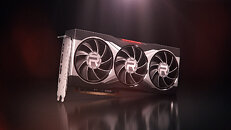
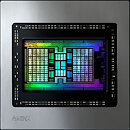
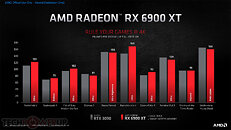
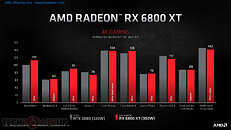
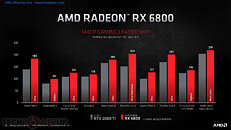
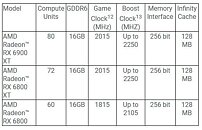
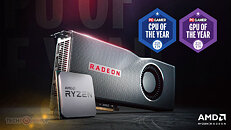
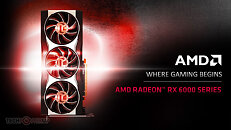
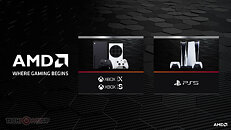
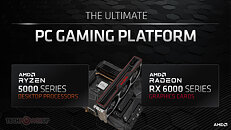
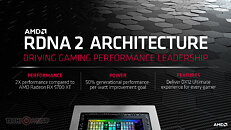
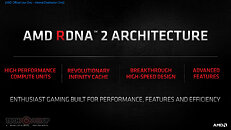
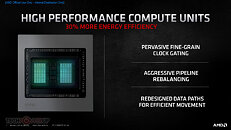
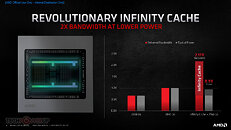
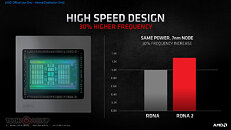
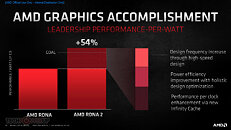
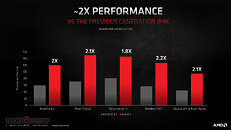
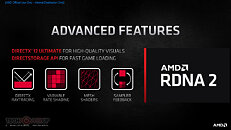
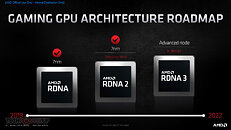
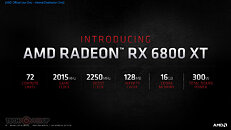
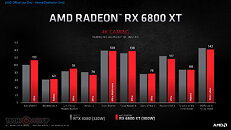
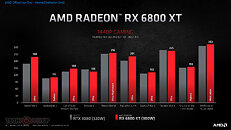
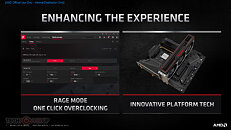
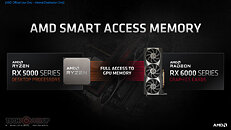
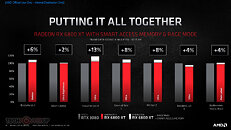
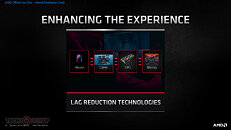
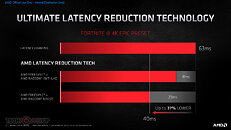
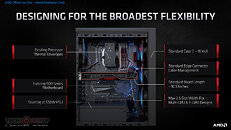
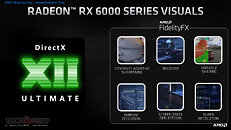
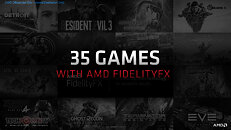

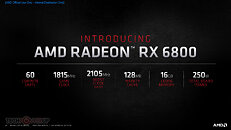
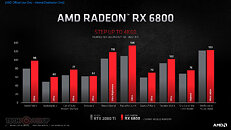
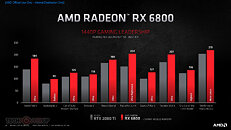
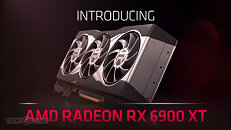
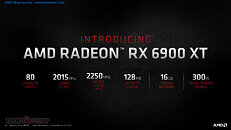
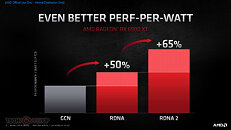
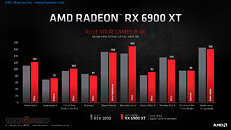
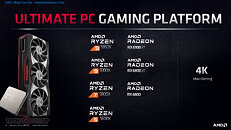
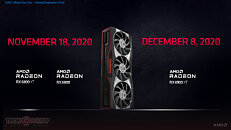
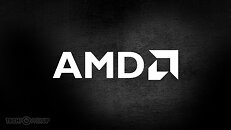
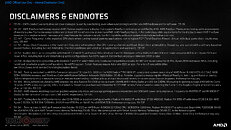
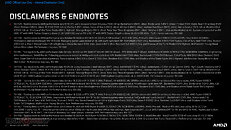
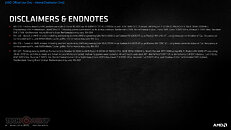
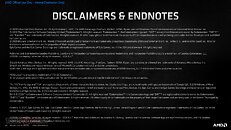
394 Comments on AMD Announces the Radeon RX 6000 Series: Performance that Restores Competitiveness
If the claims for 6800 will be confirmed with reviews, it will blow the 3070. What I wonder now is, if the 6800 can be modified/updated with the 6800XT bios for additional performance/power delivery just like the 5700 could with 5700XT's BIOS. That would be just perfect and it would give 6800 way more edge. It shouldn't be a problem since they both have 16GB of Vram.
www.businessofapps.com/data/fortnite-statistics/#:~:text=A%20survey%20conducted%20by%20Newzoo,Player%20Unknown's%20Battlegrounds%20(PUBG).Ande also here: (they didnt take unter 18 into account)
comparecamp.com/fortnite-statistics/
2080 Ti and 3070 ARE NOT the same thing. And in many cases 3070 outperformed 2080Ti, so the "18% figure" is wrong.
Other than that, it is with Smart Access Memory, that requires a Ryzen 5000. Situation for everyone else could be different, so my suggestion is stop cheerleading and wait for actual benchmarks.your comment is about anecdotal evidence at best.
There are 3 statistics that says different numbers. And "18-25" is quite different from "14 years old" as claimed above.
At 20-25 years old you absolutely know what DLSS is and if it fits your needs or not.yes I clearly stated above I DON'T KNOW, but I'm not the one making wrong assumptions here. SO the proof is on you.
You said 14 years old and I asked something to backup that claim.
16 GB for the intended target (mostly 1440P) is totally useless.Actually I don't think so.
In my opinion there are 16 years old guys more competent than people here. I was just arguing about the "Fortnite players are 14 years old so they don't know about DLSS" claimed above.yes ONE study, and it didn't show us how many "14 years old players" there were. You don't know if 90% of those players are 24 years old, because the study just put a big class 10-25.
You should learn more about statistics
Try this and look what the difference in performance between the 3070 and the 2080 Ti is. AMD didn't use 3070 because they are not available. Anyway, the 2080 Ti is a good card representing the 3070's performance. Even though they are two different cards, the performance in general is the same across the board.
I own both a 2070 Super and a 5700XT, and I'm still undecided about 3070 or 6800. I will wait for actual review before buy something.
1) Did I miss something AMD DIDN'T show to us ? There is NO 6800 vs 3070 comparison in their slides;
2) there is NO 18% speed difference even with the 2080 Ti, since it is different depending on the game used, and 6800 benchmarks were JUST with Smart Access Memory enabled, a feature that requires a Ryzen 5000. AMD purportedly omitted 6800 plain results, while they did it for 6800XT. This is called marketing;
3) but DLSS/RT are a factor, just like CUDA is for some users. CUDA doesn't matter to me but RT definitely does, and it is very strange AMD didn't show anything about that.
The point is AMD cherrypicked some benchmarks (that's absolutely normal in a marketing presentation) and you cannot say "it is 18% faster" without a proper review.
Especially because on the 6800, the mainstream card, they tested the card enabling a feature available ONLY to owners of a CPU that doesn't even really exist yet.
When Lisa says "X" it is X.
When Jensen says "X", it is never X, and by how much real is off, depends on how much pain Jensen is in.
"Cherry picked", eh, Borderlands 3:
And then there are lovely youtube channels like DF, who totally for free can figure how to trounce older card performance to make Jensen's lies to look like usual likes.That doesn't change the way you act. Even if you had "AMD" tatoo on your forehead.
I don't care about "Lisa or Jansen".
They are nothing to me.
I do care about the product, and I will choose between 6800 and 3070 the moment I will see a proper review. Not a marketing presentation.
The "way I act" is not cheerleading a brand. And it is not your business
Let's recap, all studies dismissed entries from people below the age of 18, one did concluded that 53% of players are between 10-24 and given that most other studies concluded about 30% are between 18 and 24 that likely leaves a lot of users below 18. Our resident 200IQ statistician here therefore concluded that because most studies don't included that age bracket and only one does, it must mean there is no data that shows children are playing this game. This is from someone telling me to learn statistics mind you. Tons of news reports and articles about parents being annoyed about the fact their kids play this game isn't anecdotal evidence.
More over, you go on to say people between 20-25 years absolutely know what DLSS is. Really, genius, where's the data ? If you want to play this stupid game, square up and don't say something this outrageous.
But if you are into tech and still haven't noticed that it is almost never that Jensen says truth and almost never that Lisa lies, there is something wrong.
I have NO brand loyalty at all.
Actually lately I spent much more on AMD than on other brands, and I'm considering a 6800 as my next VGA.
I'm also considering and I will wait for 6800 and xt versions reviews but the odds are what they are and pointing cherry-picking games for benchmarks or usage of AMD new developed features with support for their products is not diminishing their credibility nor should be considered as cheating in any way. The raw performance is there and it is great in comparison to NVidia's cards.
It is normal marketing and every company is doing that to create the hype and increase sales. It is their business.
I'm just saying that I will make a decision after the first review by Techspot and Guru3D.still a lot of words and no evidence about "14 years old"...